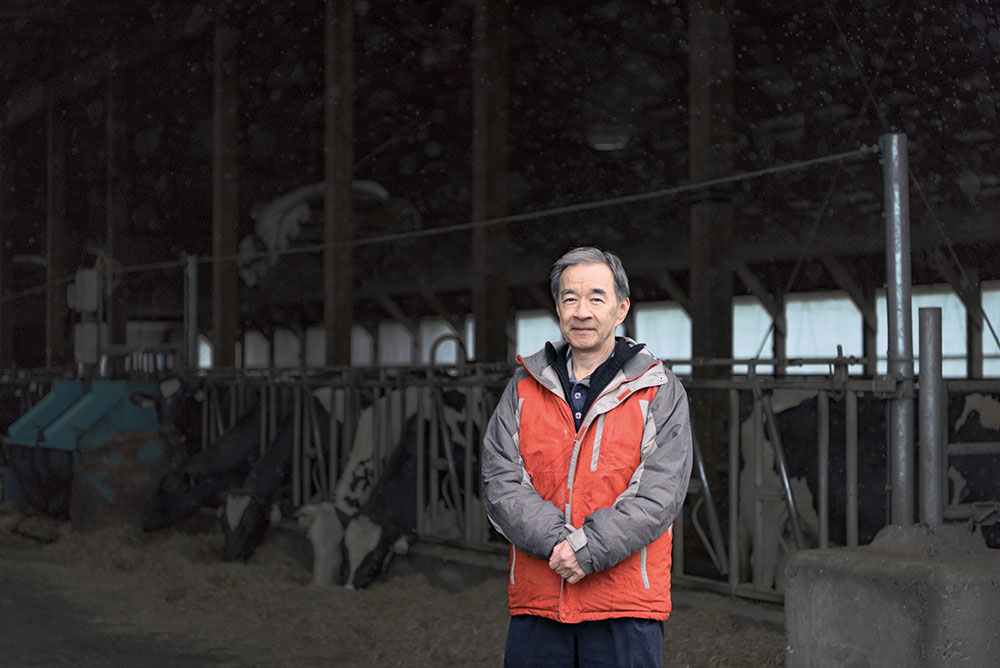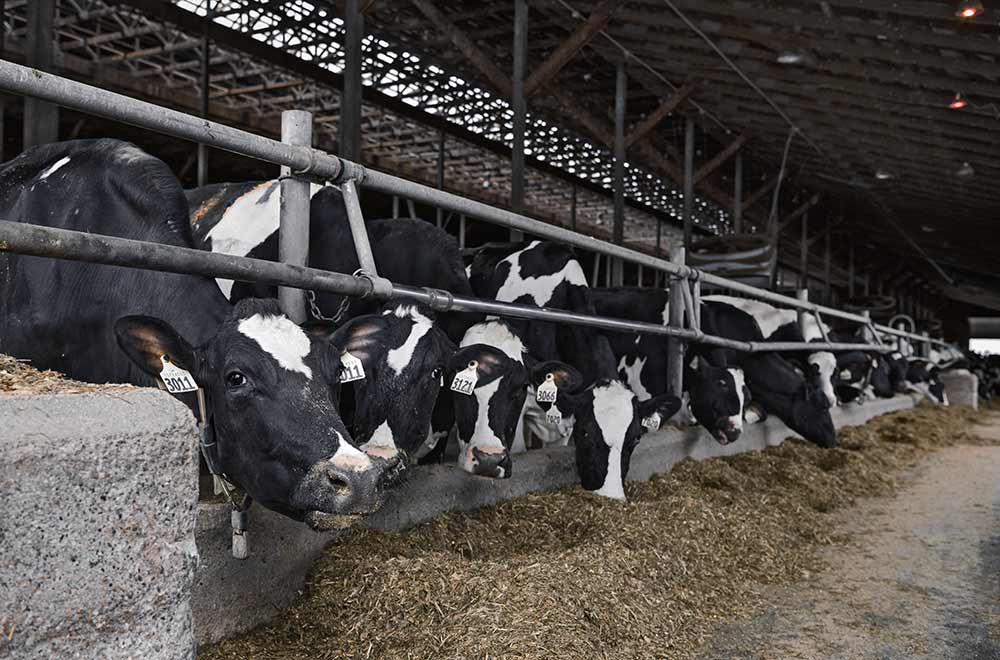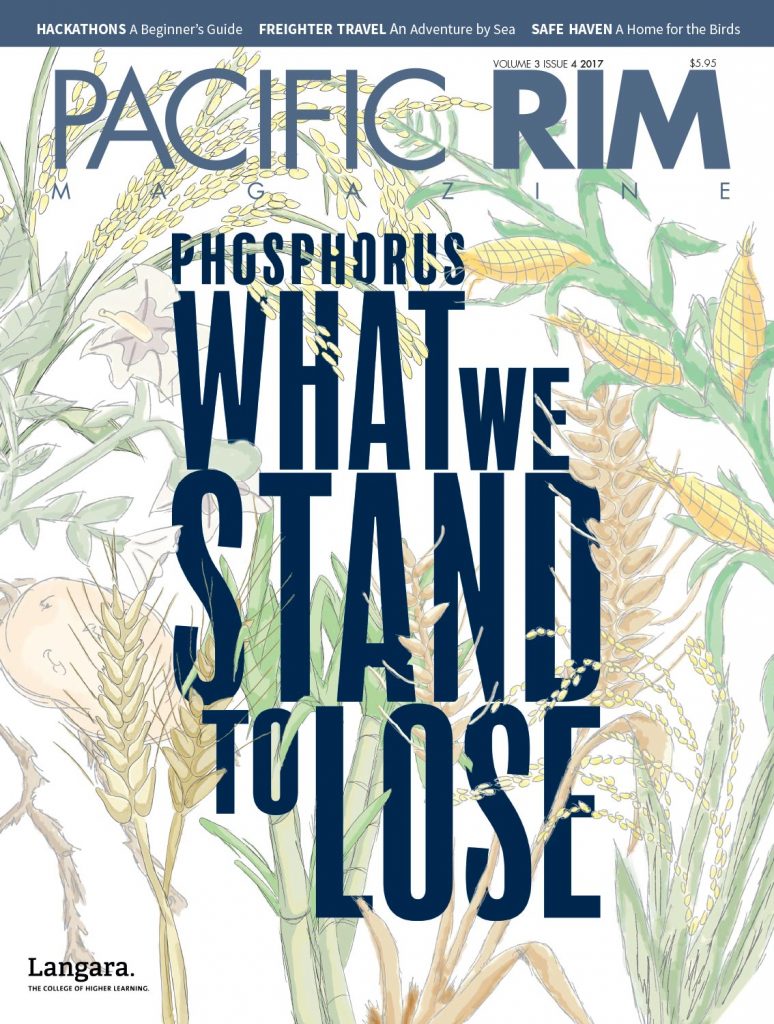Phosphorus cannot be created or destroyed. It is fifteenth on the Periodic Table of Elements, and it is one of the fundamental building blocks of life. “Absolutely everything that grows, that lives, must have phosphorus on a basic cellular level,” says Donald S. Mavinic, PhD, professor in the Civil Engineering department at the University of British Columbia (UBC). Phosphorus is an absolute necessity for growing food and, aside from being an essential ingredient in fertilizer, it can be found in everything from DNA to dynamite, from Kraft single slices of cheese to lithium-ion batteries. The needs and uses for phosphorus are plentiful, but its sources and supply are in short order.

Phosphorus is primarily mined as phosphate rock from surface deposits of two- to three-million-year-old skeletal remains of marine animals. According to Dr. Mavinic, “The largest producer and shipper of phosphate rock is Morocco, and the Moroccans control about 90 per cent of all global phosphorus reserves.” Previously China and Russia were big exporters as well, but because it is a non-renewable resource, their supply of high quality, clean, and economically extractable phosphate rock is limited. “We think there’s somewhere between 30, maybe 40 years’ supply left and that’s about it. That’s where the real problem is,” says Dr. Mavinic. Enter the idea to recover phosphorus from waste and recycle it.
Phosphorus cannot be lost in the atmosphere, because it does not have a gaseous phase. In fact, phosphorus can be used over-and-over if recovered properly. It is, however, impossible to synthesize in a lab. Dr. Mavinic says experts estimate the human body only uses about two per cent of the phosphorus it ingests and the rest is excreted. “It’s a huge waste of a valuable resource unless you get into the sewage recovery business like we did,” he says, referring to his role in founding Ostara Nutrient Recovery Technologies Inc. This internationally-acclaimed company based in Vancouver, BC, specializes in recovering nutrients from municipal and industrial wastewater in the form of struvite (magnesium, ammonium, phosphate).
Human waste is one thing, but farm animal manure is a whole other nutrient gold mine. Victor Lo, PhD, also a professor in the Department of Civil Engineering at UBC, is currently heading research into methods for recovering nutrients from farm animal manure. Dr. Lo and his team have established a process known as microwave enhanced advanced oxidation process (MW-AOP). Asha Srinivasan, PhD, who is a post-doctoral fellow at UBC and a member of Dr. Lo’s research team, describes MW-AOP as a two-part process. Part one breaks down the solids to facilitate the recovery of the nutrients in liquid form. Part two crystalizes the nutrients into struvite pellets, which are used as slow-release fertilizers.
Dr. Lo says he and his team have been very lucky to work with the UBC Dairy Education and Research Centre (UBC Dairy Centre) in Agassiz, BC, using it as a site to test and demonstrate the MW-AOP technology. An official unveiling is planned to take place within the first six months of 2017 to show how manure processing can occur on individual farms. “We’re looking at a custom designed 25-kilowatt microwave unit to do the on-site demonstration at the UBC Dairy Centre. This one should be able to treat the liquid manure from up to about 120 dairy cows operating 24 hours a day.” According to Holger Schwichtenberg, chair of Mainland Milk Producers Association, vice chair of British Columbia Dairy Association, and owner of Holberg Farms in Agassiz, the average dairy farm in the Fraser Valley has about 135 cows. This is significantly larger (in terms of cattle) than the average dairy farm in the rest of Canada, which has about 75 cows.
It may seem counter-intuitive to go through the trouble of processing animal manure into fertilizer when the manure is already rich in nutrients. According to Schwichtenberg, current manure management practice in the Fraser Valley is to spread the manure back onto the land directly in lieu of chemical fertilizer at specific times of year that make sense for the plants. Using himself as an example, Swichtenberg says, “We usually spread sometime in March, weather allowing, for the first crop of grass silage. And again, weather permitting, we apply some to our cover crop, which is planted where last year’s corn was, and then you go through the season again. The idea being that you spread what your plants require and not in excess.”
To prevent over saturating the soil with nutrients, spreading manure in the fall and winter is generally banned in BC, as these are not crop growing seasons. During these months, livestock farmers are required to store their manure. However, eventually spreading is inevitable. Dr. Lo says the MW‑AOP is only aiming to recover about half of the phosphorus available in the manure to preserve some of the phosphorus in the spreading manure. In this way, “[The operation] is sustainable, but not polluting,” says Dr. Lo. Furthermore, it ensures farmers do not have to purchase and use chemical fertilizer. They can simply use the manure produced on their farms instead.
Too many nutrients
Spreading manure directly on large areas of land is relatively safe for the environment. Spreading on small plots of land, however, can cause nutrient imbalance in the soil, according to Dr. Lo. In fact, Dr. Mavinic explains that plants take up only about 20 per cent of phosphate fertilizer. The rest builds up in the soil, eventually either contaminating the groundwater, or washing away into receiving bodies of water and causing eutrophication. “Eutrophication is an explosion of green growth, as I call it to my students,” says Dr. Mavinic. Eutrophication happens when an excess of nutrients (primarily nitrogen and phosphorus) end up in receiving bodies of water. Phosphorus, in particular, wreaks havoc because, “It is a limiting nutrient [meaning it is required by the plants in the water]. When you put too much in, it gets into the milfoil algae and all kinds of green growth in the receiving body [of water] just explodes,” says Dr. Mavinic. These algal blooms have been observed in lakes and rivers all over the world, and are of major concern due to the imbalance they cause in ecosystems. Essentially, algal blooms suffocate all other forms of life in a body of water.

According to Environment Canada, signs of eutrophication in North America first appeared in the Great Lakes, primarily in Lake Erie, in the 1960s. In 1972, Canada and the United States signed the Great Lakes Water Quality Agreement (GLWQA) with the goal of preserving the Lakes by reducing the amount of nutrient pollution and restoring the Lakes’ ecosystems. It is a slow and arduous process. “We’re almost 50 years at this and the [GLWQA] are still having problems,” says Dr. Mavinic. “It’s not that easy to undo once the damage is done.”
Technologies to recover phosphorus could be key in preventing further damage to the environment due to eutrophication. Referring to the upcoming demonstration at the UBC Dairy Centre, Dr. Srinivasan says, “Hopefully that will generate awareness towards phosphorus recovery from animal manure, and in general about manure management, so we will be able to help move towards improving the sustainability of manure management practices, especially in the Fraser Valley.”
Dr. Lo would like to see MW-AOP commercialized. Down the line, farmers could sell the struvite pellets as fertilizer to generate additional revenue. Dr. Lo says it would be up to individual farmers to decide if they would pursue this, but the notion of seeing a monetary return on animal manure is an innovative one. It could be a great opportunity for BC dairy farmers in particular, as the Fraser Valley region offers optimal dairy farming conditions such as a moderate climate, a long growing season, plenty of water, and fertile soils.
Schwichtenberg hints at changing mindsets and acknowledges that the dairy industry is committed to recognizing advances in science, social responsibility, and consumer confidence. “Not everybody quite thinks that way yet,” he says. “It takes time, it takes effort, it takes money.” Drs. Mavinic and Lo know the technology to recover phosphorus from waste is functionally there, but is not widely accepted yet. Dr. Mavinic says one of the biggest challenges has been dealing with municipal governments. Dr. Lo says research funding has been a big problem. Dr. Srinivasan agrees, and adds raising awareness and creating incentives for implementation to the list.
The fact of the matter is phosphorus is essential for all life, and we are running out. It is imperative that we accept and adopt technologies to recycle it. “The biggest message is that we have to take this very seriously,” says Dr. Mavinic. “People don’t even talk about phosphate or realize how important it is, but you can’t do business without it; we cannot survive. Every life form requires it right down to the cellular, molecular level. You need water, but you also need phosphorus and we better start paying attention.”











